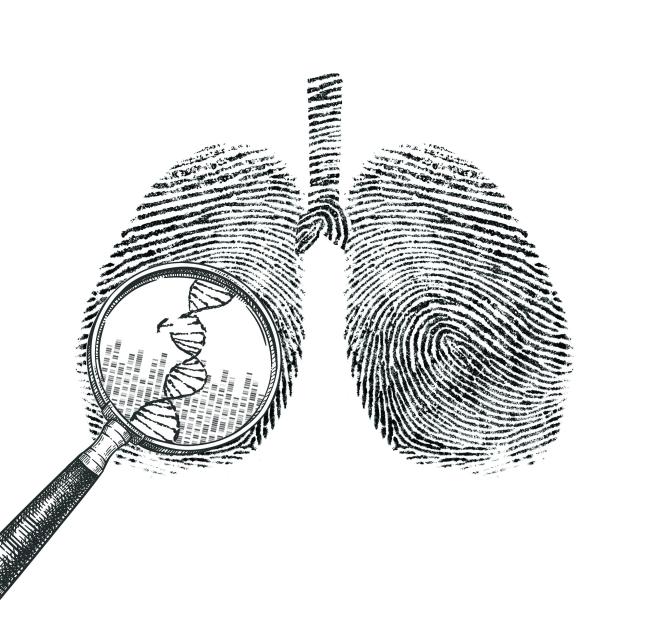Genomic origins of lung cancer in never smokers
September 21, 2021
Genomic origins of lung cancer in never smokers
At a Glance
- Researchers identified three subtypes of lung cancers in people who never smoked.
- The results could help guide more precise lung cancer treatments.

About two million people are diagnosed with lung cancer each year, making it the leading cause of cancer-related deaths. About one tenth to one quarter of all lung cancers occur in people who have never smoked. Yet most genomic studies of lung cancer have been done in cancers from people who smoked at some point in their lives. Thus, the genomic features of lung cancer in never smokers have been poorly understood.
A research team led by Maria Teresa Landi at NIH’s National Cancer Institute (NCI) sequenced the genomes of tumors from 232 lung cancer patients who never smoked. The tumors included 189 adenocarcinomas (the most common type of lung cancer), 36 carcinoids, and seven other tumors of various types. The patients had not yet undergone treatment for their cancer.
Besides NCI, NIH’s National Institute of Environmental Health Sciences (NIEHS) and National Heart, Lung, and Blood Institute (NHLBI) also supported the research. Results appeared in Nature Genetics on September 6, 2021.
The researchers did not find patterns of mutations associated with smoking, even among patients who reported exposure to secondhand smoke. This may be the result of several factors: the number of patients exposed to secondhand smoke was small, there may have been a wide range in exposure to secondhand smoke, and the methods may not have been sensitive enough to detect small numbers of mutations from secondhand smoke.
Even so, the results suggest that lung cancer in never smokers results from mechanisms distinct from that caused by smoking. The team identified 3 subtypes of tumors based on a type of mutation called copy number alterations. In these mutations, a section of a chromosome gets duplicated or deleted. They named these subtypes after musical terms for relative “loudness.”
The “piano” (quiet) subtype was most common, accounting for almost half of the never smokers’ tumors. It featured fewer mutations than the other two subtypes and larger variation among cells within the same tumor. Piano tumors also had the longest telomeres—the DNA sequences that mark the ends of chromosomes. This suggests that the tumor cells had divided fewer times than the other subtypes.
The researchers estimated that in piano tumors, driver mutations—the ones that allow tumor cells to grow and spread—first occurred, on average, about a decade before diagnosis. These tumors therefore grew very slowly. The unique features of the piano subtype suggest that at least some of them were derived from reactivated stem cells.
By contrast, the “mezzo-forte” (moderately loud) and “forte” (loud) tumors appeared to grow much faster than the piano tumors. Mezzo-forte tumors featured duplications of specific chromosome segments. They also often had mutations in a gene, EGFR, that is commonly altered in lung cancer. In forte tumors, the entire genome was often duplicated, which is often seen in lung cancers among people who smoke. Five mutations often found in forte and mezzo-forte were each estimated to double the risk of death.
“What we’re seeing is that there are different subtypes of lung cancer in never smokers that have distinct molecular characteristics and evolutionary processes,” Landi says. “In the future we may be able to have different treatments based on these subtypes.”
Related Links
- New Genetic Regions Linked to Risk of Melanoma
- Genomic Analysis of 33 Cancer Types Completed
- Gene Changes Identified in Most Common Lung Cancer
- Gene Variations Linked to Lung Cancer in Non-Smokers
- Large-Scale Genetic Study Sheds Light on Lung Cancer
- Smoking Alters Gene Activity in Lungs and Tumors
- Lung Cancer
References
Genomic and evolutionary classification of lung cancer in never smokers. Zhang T, Joubert P, Ansari-Pour N, Zhao W, Hoang PH, Lokanga R, Moye AL, Rosenbaum J, Gonzalez-Perez A, Martínez-Jiménez F, Castro A, Muscarella LA, Hofman P, Consonni D, Pesatori AC, Kebede M, Li M, Gould Rothberg BE, Peneva I, Schabath MB, Poeta ML, Costantini M, Hirsch D, Heselmeyer-Haddad K, Hutchinson A, Olanich M, Lawrence SM, Lenz P, Duggan M, Bhawsar PMS, Sang J, Kim J, Mendoza L, Saini N, Klimczak LJ, Islam SMA, Otlu B, Khandekar A, Cole N, Stewart DR, Choi J, Brown KM, Caporaso NE, Wilson SH, Pommier Y, Lan Q, Rothman N, Almeida JS, Carter H, Ried T, Kim CF, Lopez-Bigas N, Garcia-Closas M, Shi J, Bossé Y, Zhu B, Gordenin DA, Alexandrov LB, Chanock SJ, Wedge DC, Landi MT. Nat Genet. 2021 Sep;53(9):1348-1359. doi: 10.1038/s41588-021-00920-0. Epub 2021 Sep 6. PMID: 34493867.
Funding
NIH’s National Cancer Institute (NCI), National Institute of Environmental Health Sciences (NIEHS), and National Heart, Lung, and Blood Institute (NHLBI); Wellcome Trust and Burroughs Wellcome Fund; National Institute for Health Research Oxford Biomedical Research Centre; V Foundation; Alfred P. Sloan Foundation; David & Lucile Packard Foundation; Fondation Institut Universitaire de Cardiologie et de Pneumologie de Québec; Italian Ministry of Health; Damon Runyon Cancer Research Foundation; Thoracic Foundation; Ellison Foundation; American Lung Association; Harvard Stem Cell Institute; European Research Council; Association pour la Recherche contre le Cancer.


